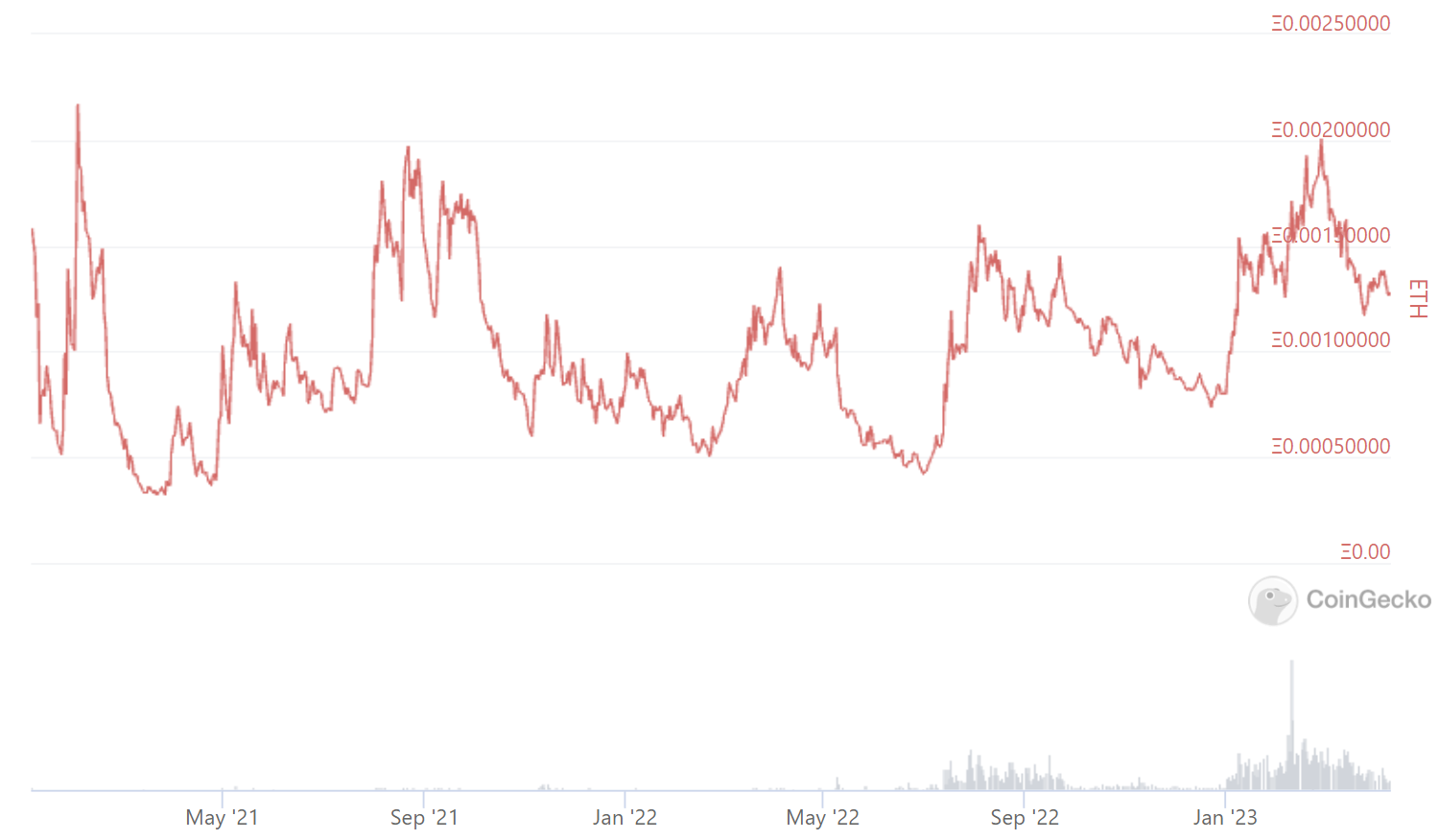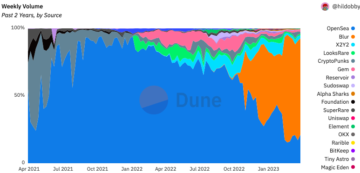This report was written by IOSG Ventures and published exclusively on The Defiant.
TLDR:
- The article discusses the current state of the Ethereum staking market as Ethereum has shifted to Proof of Stake (PoS) and is about to introduce withdrawals on April 12th with the highly anticipated Shanghai upgrade.
- We explore two questions in depth: firstly, whether staking will be a winner-takes-all market; and secondly, what is the expected total staked ETH.
- Currently, ETH staking is dominated by Lido, a non-custodial staking platform, which is closely followed by centralized entities such as Coinbase, Kraken and Binance. We expect Lido’s market share to remain in the 30-35% range.
- Overall, we anticipate that the Shanghai upgrade will result in a surge of new stakes in the short to medium term, but we expect that the percentage of ETH staked will remain modest compared to other POS chains.
Since the early days of Bitcoin and blockchains there were centralized intermediaries facilitating the exchange of crypto between different users. Only with the introduction of Ethereum, it became possible to build non-custodial dApps enabling users to trade their cryptos without a trusted middleman.
Yet, centralization still reigns supreme in the key application verticals including trading, lending and fund custody. The dangers of this centralization were made all too clear in 2022, with major lenders facing controversies and one of the largest exchanges, FTX, declaring bankruptcy after alleged fraud.
NFTs are a novel phenomenon, birthed from decentralized protocols and programmable blockchains, and for a time, were the only arena where centralized players couldn’t keep pace with their decentralized counterparts. But with Ethereum’s shift to Proof of Stake (POS) and the absence of native staking options for users, a new playing field emerged: staking pools.
Staking is an important feature for PoS blockchains because it provides a mechanism for securing the network and incentivizing users to maintain its integrity. By requiring users to have skin in the game in the form of staked & slashable tokens, PoS networks discourage malicious behavior and reward users for following the rules and maintaining the network.
Staking pools combine the resources of many distinct participants and collectively stake a larger amount of tokens, thus increasing their chances of being chosen to create new blocks. Besides, staking pools help smaller validators who may not have enough tokens to stake individually to still participate in the network and earn rewards.
Traditionally, staking requires locking up tokens for a set period of time, which can make them illiquid and generate opportunity costs for the staker. With liquid staking, however, users can stake their ETH through a third-party service provider / protocols, who then issues a liquid representation of the staked ETH. The liquid representation can be freely traded or used as collateral, while still earning staking rewards.
ETH staking attracted interest from both non-custodial and custodial entities. The outcome of the competition between the two could have significant implications for Ethereum’s future. If centralized players come to dominate the market, it would be a massive setback for Ethereum’s decentralized ethos.
As seen in the chart below, Lido, a non-custodial staking protocol, is currently leading the charge, capturing a commanding 30% of ETH staking market share. Nevertheless, it is being followed closely by centralized entities such as Coinbase, Kraken and Binance.
 Cumulative ETH staked; Source: Dune
Cumulative ETH staked; Source: Dune

Yet, some influential voices in the Ethereum community have been pushing for limits to Lido’s growth. Vitalik Buterin, for example, has argued that staking projects, both custodial and non-custodial, should set self-imposed caps, proposing a 15% threshold.
On the other hand, some ignore community pressure and argue that this market could easily become a winner-takes-all scenario, driven by factors such as liquidity, composability, network effects, professionalization, and yield optimization. But considering the values and goals of the Ethereum community and the desire for more distributed staking, it raises the question of just how much market share would be controlled by the market leader.
While Lido has firmly rejected the notion of self-imposed restrictions, it’s unlikely that they’ll capture a monopoly of the market. In relative terms, Lido’s share surpassing 30-35% interval would be a surprise. Below, we explore factors that could prevent Lido from winning it all.
Shanghai Impact
While the Shanghai hard fork is expected to result in a confidence boost for the staking vertical and encourage a larger number of depositors to tap into staking products, the upgrade could lessen the moat of Lido.
Namely, the inability to withdraw deposited ETH was one of the defensibility layers of Lido. As the market leader with the most liquid staked ETH token, Lido offered higher guarantees to depositors that they would be able to exit back to stablecoins or other assets anytime without a significant discount.
However, with near-instant withdrawals, this defensibility layer disappears as depositors could always convert back to native ETH in a matter of hours/days. This may lead to more willingness from depositors to experiment with novel designs or choose protocols that have a different set of trade-offs compared to Lido.
Also, centralized players may offer products that enable even faster withdrawal options, which could sway users towards convenience.
Competition
Besides, fierce competition offering a different set of trade-offs to the end-user is yet to truly challenge Lido’s market dominance. Until recently, Lido was pretty much the only viable decentralized staking protocol. Without Lido, it is likely that centralized players would have dominated the ETH staking market.
However, today, most of Lido’s non-custodial competitors are maturing and becoming possible alternatives for the stakers that value decentralization. In addition, while Lido has already distributed most of its tokens to a different set of stakeholders, its competitors still have gas in the tank and could leverage innovative token design to lure ETH depositors to their protocols. Yet, while token incentives can indeed be powerful for gaining short-term traction, robust design choices and UX determine long-term winners.
In addition, a Lido fork is always possible, though it’s impossible to predict its impact. How large of a threat this fork could be to Lido depends on various factors, such as LDO governance decisions, timing, innovations in the fork (e.g. on the governance level), and the legitimacy of the fork’s core contributors. It is likely that some community members are closely monitoring nascent Lido governance and waiting for any significant mistake to create a fork.
Furthermore, the staking market is still nascent and might see waves of disruptions. For instance, if successful, restaking has disruptive potential. Namely, Eigen Layer introduces the optionality for ETH stakers to accept additional risk and participate in securing different middleware, thus enabling increased utilization of their resources and finding additional sources of revenue beyond ETH staking yield.
While Eigen could be complementary to LSDs, it can also interact with stakers directly. It is more likely to further incentivize solo staking since these participants manage their own hardware and have the capability to serve middleware. Thus, the abundant economic opportunities on top of Eigen could potentially take the market share out of the existing LSD solutions.
The Importance of L (Liquidity) In LSD
Those that believe that Lido could capture the whole market, build this expectation based on the premise that the market leader is entitled to network effects. Below we explore whether such effects are overestimated.
The conventional wisdom states that:
- users will navigate toward the LSD with the best market liquidity for exit purposes
- the deepest liquidity makes LSD suitable collateral in many DeFi protocols, providing more use cases to its holders
- more use cases would make such token even more liquid, and the circle repeats
First of all, as mentioned earlier, there’s the issue of opportunity cost and illiquidity. When withdrawals aren’t possible, the liquidity of an LSD becomes a critical factor. But with the advent of near-instant withdrawals, this advantage is diminished to a large extent. Still, Lido has certainly leveraged pre-Shanghai period to get most integrations with leading DeFi protocols such that stETH holders can benefit from DeFi composability.
Yet, are token holders really so eager to use their ETH in on-chain applications?
Looking at the recent bull cycle, despite the hype around DeFi, NFTs, and gaming, as well as attractive yield farming schemes, a relatively small fraction of ETH has actually been used in smart contracts, where at the peak of the bull market there were roughly 18.5% of ETH tokens used in smart contracts.

Given this, it’s reasonable to ask: would a relatively modest staking yield move the needle much above 20%, especially after the high yield of the past bull market failed to do so?
Besides, it’s worth noting that not all DeFi protocols support rebase tokens like stETH, leading to two standards in the Lido ecosystem – stETH and wrapped stETH (the latter generally trades at a premium due to its accruing rewards). This causes friction for users who have to wrap and unwrap stETH when using some of the largest DeFi protocols such as MakerDAO, Balancer and Euler. Currently, most stETH tokens are concentrated in just two protocols, AAVE and Curve.fi, further limiting the token’s potential reach in the DeFi landscape.


How Large Is the Pie?
The current staking percentage of ETH is among the lowest among larger PoS chains. Some tend to make simplistic analogies and expect ETH staking to grow purely because other chains have a much larger percentage at stake. However, Ethereum is somewhat peculiar due to the following:
- the inability to unstake (soon to disappear),
- the absence of protocol-level staking that requires the introduction of another layer of smart contract risk,
- ETH’s status as a mainstream asset with a more diverse community makes it less susceptible to large-scale staking by insiders
We do expect the Shanghai upgrade to create an environment for larger-scale staking. Moreover, as new smart contracts and custody solutions are battle-tested, the security risk would become less of a concern. However, the notion that more than 50% of ETH supply could be locked in staking contracts anytime soon does seem like a wild dream considering everything discussed above.
On Lido Fundamentals
Although Lido is a multi-chain protocol, its fundamentals are essentially tied to Ethereum activity and ETH price. Nearly all of Lido’s TVL is on Ethereum, and the platform generates revenue from Ethereum inflation rewards and transaction fees. Lido collects 5% of the staking rewards generated on its platform, with the majority (90%) going to stETH holders and the rest going to node operators.
However, Lido still experiences volatility even when priced in ETH, which could be attributed to markets re-evaluating Lido’s position within the staking vertical and the estimated size of the LSD market. These two factors are the core drivers of Lido’s future revenue generation potential.

It’s also important to understand the dynamics of ETH inflation, as it often makes up the majority of Lido’s revenue. According to data from Ultra Sound Money, a 1% increase in total staked ETH results in a 0.41% decrease in base reward APY. Thus, the overall increase in staked ETH will not necessarily lead to a linear increase in the revenue of staking protocols, unless there is a substantial jump in on-chain activity to compensate for the diminishing base rewards.
Market Expectations
The market excitement about the liquid staking vertical is evident when we compare the multiples (P/S) at which the market is pricing LSD projects vs some other DeFi protocols.
For instance, Lido, which is priced more conservatively than its competitors such as Rocket Pool or Stakewise, still has much more aggressive multiples than DeFi ‘veteran’ MakerDAO, with a P/S ratio of approximately 80 compared to Maker’s 37.
MakerDAO is not just a random benchmark, it shares similarities with the staking vertical as LSDs are essentially synthetic assets, similar to Maker’s DAI. It wouldn’t be surprising if some of the LSDs eventually even choose to issue their own synthetic stablecoin.
Lido had a significant boost in the multiple around the time when the Shanghai upgrade timeline became more clear, after which it experienced a slight decrease due to a drop in LDO price on the one hand and an increase in protocol fees on the other.
Unless Lido or Maker DAO starts exploring new narratives or experience any significant idiosyncratic events, in the medium term, we should expect the multiples of the two projects to somewhat converge.
Assuming that Lido multiple converges to 50 over the short term, with a simplified assumption of 5% APY, in order to justify the existing price level Lido would have to grow its TVL by approximately 70%.
Conclusion
The nascent liquid staking sector is likely to undergo significant volatility in the coming months as the market reevaluates the overall size of the staking market and the positioning of individual players.
Despite calls from the community to limit the size of individual validator pools, we anticipate that a power law distribution will emerge in this sector, with only a few players controlling a dominant market share. However, we do not believe this will result in a winner-takes-all market, and we expect that no single player will control more than 35% of the market share.
Furthermore, we are skeptical that the Shanghai upgrade will bring the percentage of staked ETH in line with other major Proof of Stake chains, and we believe that the appetite of ETH holders for staking is somewhat overestimated.
While Lido enjoys a first-mover advantage and is widely regarded as the most secure way to stake ETH, it has yet to face competition from maturing rivals that can leverage token incentives to entice Lido’s depositors.
Disclaimer: IOSG is an investor in Stakewise, Swell, and Eigen Layer.
- SEO Powered Content & PR Distribution. Get Amplified Today.
- Platoblockchain. Web3 Metaverse Intelligence. Knowledge Amplified. Access Here.
- Source: https://thedefiant.io/could-lido-dominate-post-shanghai/
- :is
- $UP
- 15%
- 2022
- 35%
- a
- aave
- Able
- About
- above
- Accept
- According
- activity
- actually
- addition
- Additional
- ADvantage
- advent
- After
- aggressive
- All
- alleged
- already
- alternatives
- always
- among
- amount
- and
- Another
- anticipate
- Anticipated
- appetite
- Application
- applications
- approximately
- April
- APY
- ARE
- Arena
- argue
- around
- article
- AS
- asset
- Assets
- assumption
- At
- attracted
- attractive
- back
- balancer
- Bankruptcy
- base
- based
- BE
- because
- become
- becomes
- becoming
- being
- believe
- below
- Benchmark
- benefit
- BEST
- between
- Beyond
- binance
- Bitcoin
- blockchains
- Blocks
- boost
- bring
- build
- bull
- Bull Market
- Buterin
- by
- Calls
- CAN
- caps
- capture
- Capturing
- cases
- causes
- Centralization
- centralized
- Centralized Intermediaries
- certainly
- chains
- challenge
- chances
- charge
- Chart
- choices
- Choose
- chosen
- Circle
- clear
- closely
- coinbase
- CoinGecko
- Collateral
- collectively
- collects
- combine
- come
- coming
- community
- compare
- compared
- competition
- competitors
- complementary
- Concentrated
- Concern
- confidence
- considering
- contract
- contracts
- contributors
- control
- controlled
- controlling
- convenience
- conventional
- converge
- convert
- Core
- Cost
- Costs
- could
- create
- critical
- crypto
- cryptos
- Current
- Current state
- Currently
- custodial
- Custody
- cycle
- DAI
- dangers
- DAO
- DApps
- data
- Days
- Decentralization
- decentralized
- decisions
- decrease
- deepest
- DeFi
- DeFi landscape
- DeFi protocols
- depends
- deposited
- depositors
- depth
- Design
- designs
- Despite
- Determine
- different
- diminishing
- directly
- disappear
- Discount
- discussed
- disruptions
- disruptive
- distinct
- distributed
- distribution
- diverse
- Dominance
- dominant
- dominate
- dream
- driven
- drivers
- Drop
- dynamics
- e
- Earlier
- Early
- earn
- Earning
- easily
- Economic
- ecosystem
- effects
- emerged
- enable
- enabling
- encourage
- enough
- entities
- Environment
- especially
- essentially
- estimated
- ETH
- eth price
- eth stakers
- eth staking
- ETH token
- Ether (ETH)
- ethereum
- ethereum staking
- Ethereum's
- Ethos
- Even
- events
- eventually
- everything
- example
- exchange
- Exchanges
- Excitement
- exclusively
- existing
- Exit
- expect
- expectation
- expected
- experience
- experienced
- Experiences
- experiment
- explore
- Exploring
- extent
- Face
- facilitating
- facing
- factors
- Failed
- farming
- faster
- Feature
- Fees
- few
- field
- fierce
- finding
- firmly
- followed
- following
- For
- fork
- form
- fraction
- fraud
- friction
- from
- FTX
- fund
- Fundamentals
- further
- future
- gaining
- game
- gaming
- GAS
- generally
- generate
- generated
- generates
- generation
- get
- Goals
- going
- governance
- Grow
- Growth
- guarantees
- hand
- Hard
- hard fork
- Hardware
- Have
- help
- High
- High Yield
- higher
- highly
- holders
- How
- However
- http
- HTTPS
- Hype
- Impact
- implications
- importance
- important
- impossible
- in
- inability
- Incentives
- incentivize
- Including
- Increase
- increased
- increasing
- individual
- Individually
- inflation
- Influential
- innovations
- innovative
- instance
- integrations
- integrity
- interact
- interest
- intermediaries
- introduce
- Introduces
- Introduction
- investor
- issue
- issues
- IT
- ITS
- jump
- Keep
- Key
- Kraken
- landscape
- large
- large-scale
- larger
- largest
- Law
- layer
- layers
- LDO
- LDO price
- lead
- leader
- leading
- legitimacy
- lenders
- lending
- Level
- Leverage
- LIDO
- like
- likely
- LIMIT
- limits
- Line
- Liquid
- liquid staking
- Liquidity
- locked
- long-term
- made
- Mainstream
- maintain
- major
- Majority
- make
- maker
- Maker DAO
- MakerDao
- MAKES
- manage
- many
- Market
- Market Dominance
- Market Leader
- Markets
- massive
- Matter
- May..
- mechanism
- medium
- Members
- mentioned
- might
- mistake
- monitoring
- months
- more
- Moreover
- most
- move
- multi-chain
- multiple
- namely
- narratives
- nascent
- native
- Navigate
- nearly
- necessarily
- network
- network effects
- networks
- Nevertheless
- New
- NFTs
- node
- Node Operators
- non-custodial
- Notion
- novel
- number
- of
- offer
- offered
- offering
- on
- On-Chain
- on-chain activity
- ONE
- operators
- opportunities
- Opportunity
- optimization
- Options
- order
- Other
- Outcome
- overall
- own
- Pace
- paradigm
- participants
- participate
- past
- Peak
- peculiar
- percentage
- period
- phenomenon
- platform
- plato
- Plato Data Intelligence
- PlatoData
- player
- players
- playing
- pool
- Pools
- PoS
- position
- positioning
- possible
- potential
- potentially
- power
- powerful
- predict
- Premium
- pressure
- pretty
- prevent
- price
- pricing
- Products
- projects
- proof
- Proof-of-Stake
- protocol
- protocols
- provider
- provides
- providing
- published
- purely
- Pushing
- question
- Questions
- raises
- random
- range
- ratio
- reach
- reasonable
- recent
- recently
- relatively
- remain
- report
- representation
- requires
- Resources
- REST
- restrictions
- result
- Results
- revenue
- Reward
- Rewards
- Risk
- rivals
- robust
- rocket
- Rocket Pool
- roughly
- rules
- scenario
- schemes
- sector
- secure
- securing
- security
- serve
- service
- Service Provider
- set
- shanghai
- Share
- Shares
- shift
- Short
- short-term
- should
- significant
- similar
- similarities
- simplified
- since
- single
- Size
- skeptical
- Skin
- small
- smaller
- smart
- smart contract
- Smart Contracts
- So
- Solutions
- some
- somewhat
- Soon
- Sound
- Source
- Sources
- stablecoin
- Stablecoins
- stake
- Staked
- Staked ETH
- stakeholders
- stakers
- STAKEWISE
- Staking
- Staking Rewards
- standards
- starts
- State
- States
- Status
- stETH
- Still
- substantial
- successful
- such
- suitable
- supply
- support
- Supreme
- surge
- surprise
- surprising
- susceptible
- synthetic
- synthetic assets
- Take
- tank
- Tap
- terms
- that
- The
- The Defiant
- the security
- their
- Them
- These
- third-party
- threat
- threshold
- Through
- Tied
- time
- timeline
- timing
- to
- today
- token
- Token Design
- token holders
- Tokens
- too
- top
- Total
- toward
- towards
- traction
- trade
- traded
- trades
- Trading
- transaction
- Transaction Fees
- trusted
- TVL
- ultrasound
- understand
- upgrade
- use
- users
- ux
- Validator
- validators
- value
- Values
- various
- verticals
- viable
- vitalik
- vitalik buterin
- VOICES
- Volatility
- vs
- Waiting
- waves
- Way..
- WELL
- What
- What is
- whether
- which
- while
- WHO
- widely
- Wild
- will
- Willingness
- winners
- winning
- wisdom
- with
- withdraw
- withdrawal
- Withdrawals
- within
- without
- worth
- would
- wrap
- Wrapped
- written
- Yield
- yield farming
- zephyrnet









![[SPONSORED] MetaMask Learn: Navigate Web3 Like a Fox](https://platoaistream.net/wp-content/uploads/2023/02/sponsored-metamask-learn-navigate-web3-like-a-fox-360x240.png)

